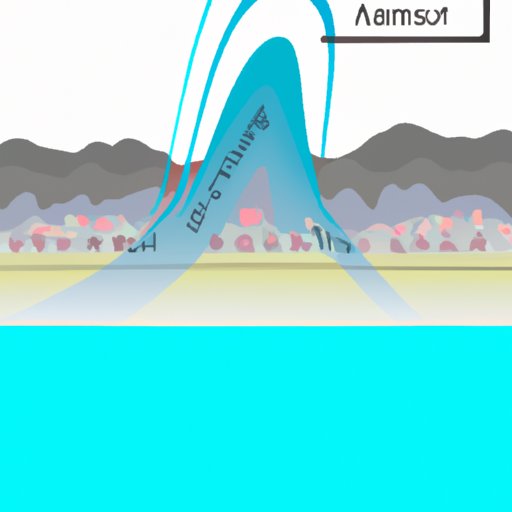Introduction
A tsunami is a series of waves created by a sudden displacement of water, usually caused by an earthquake, volcanic eruption, or underwater landslide. The force of a tsunami can be devastating, resulting in destruction of coastal areas, flooding, and loss of life. This article will explore how far a tsunami can travel inland, the potential effects it can have, and recent technological advancements that help predict and track tsunamis.
Comparing Historical Tsunami Events
To determine the typical inland reach of a tsunami, we must examine past events. For example, the 2004 Indian Ocean tsunami reached up to 10 kilometers (6 miles) inland in some areas. In 2011, the Tohoku tsunami traveled as far as 6 kilometers (3.7 miles) inland along Japan’s east coast. These events demonstrate that tsunamis can travel several kilometers inland, depending on the geography of the region.
When analyzing the geography of a region, it is important to consider factors such as the gradient of the coastline, the presence of valleys, and the depth of the ocean. A steeper gradient, for instance, will cause the waves to lose energy more quickly, thus reducing their reach. Similarly, a valley can provide a pathway for the water to travel further inland. As a result, the geography of a region greatly influences the distance a tsunami can travel.
Exploring the Impact of a Tsunami Reaching Further Inland
If a tsunami is able to travel further inland, the effects can be catastrophic. Coastal communities are particularly vulnerable to the destructive force of a tsunami, as the waves can wash away homes, businesses, and infrastructure. Further inland, however, the impact can be just as devastating, with flooding, landslides, and other forms of destruction.
Tsunamis can be caused by a variety of factors, including earthquakes, landslides, and volcanoes. Each of these events has unique characteristics that can influence the travel distance. For instance, earthquakes tend to generate larger waves than landslides, which can lead to a greater reach. Volcanic eruptions, on the other hand, can create smaller waves but can still cause significant damage.
Investigating Recent Technological Advancements
Experts are constantly working to better understand the danger posed by tsunamis and develop new ways to predict and track them. One of the most promising advances is the use of deep-ocean sensors, which can detect changes in water pressure and alert officials of an impending tsunami. Additionally, researchers are utilizing satellite imagery and computer models to gain a better understanding of the speed and direction of a tsunami.
These technological advancements are providing us with invaluable information about tsunamis, allowing experts to make more accurate predictions and giving people more time to prepare for an incoming wave. While there is still much work to be done, these tools are helping us to better prepare for and mitigate the effects of a tsunami.
Conclusion
This article has explored how far a tsunami can travel inland and the potential effects it can have. We have examined historical events to determine a typical range and analyzed the geography of the region to understand likely reach. We have also discussed the impact on coastal and inland communities and investigated recent technological advancements that help predict and track tsunamis.
It is clear that tsunamis can cause immense destruction and that the potential range is largely dependent on the geography of the region. However, by utilizing the latest technologies, we can better prepare for and mitigate the effects of a tsunami. With continued research and action, we can reduce the risk of devastation and save lives.
(Note: Is this article not meeting your expectations? Do you have knowledge or insights to share? Unlock new opportunities and expand your reach by joining our authors team. Click Registration to join us and share your expertise with our readers.)
